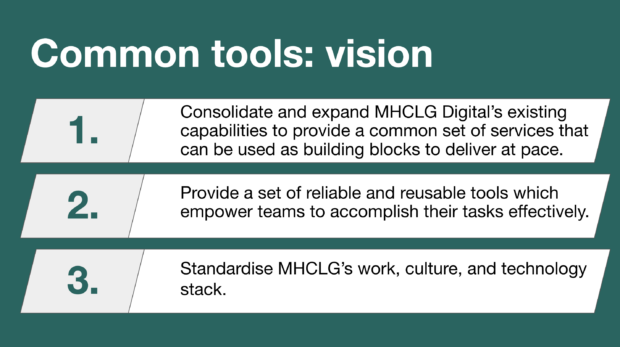Delivering at pace: introducing Common Tools as a Service

For the past 18 months, my team and I have been leading a new initiative at MHCLG called Common Tools as a Service (CTaaS). This work has emerged from MHCLG Digital’s previous experiences and lessons learned in building services at pace and scale, particularly during emergency scenarios. After conducting a thorough discovery and alpha phase, CTaaS has officially taken shape as a vital area in MHCLG Digital.
CTaaS is set to become an expanding area of MHCLG Digital, with multiple product teams expected to develop products and services under its umbrella over the next 3 years.
Our mission is threefold:
To consolidate and expand MHCLG Digital’s existing capabilities to provide a common set of services that can be used as building blocks to deliver at pace. To provide a set of reliable and reusable tools which empower teams to accomplish their tasks effectively. To standardise MHCLG’s work, culture, and technology stack.Throughout our journey, we’ve uncovered crucial insights that have shaped the CTaaS approach. I will talk about them below.
Interoperability is key
We discovered that tools cannot exist in isolation. The ability of different systems and tools to work together seamlessly is paramount. This realisation led to the creation of our Common Tools Principles, which guide the development and implementation of all CTaaS offerings:
Usability – Consider the tool's user-friendliness and the learning curve required for employees to use it effectively. Security – Assess the tool's security measures and data protection capabilities to ensure it meets the National Cyber Security Centre’s guidance. Support and maintenance – Look into the tool’s support offerings and the tool's long-term maintenance requirements to guarantee seamless functioning. Integration and compatibility – Check if the tool can integrate smoothly with existing applications and services used within MHCLG and if it is compatible with the department’s current infrastructure and technology stack. Flexibility – Examine whether the tool can be customised and configured to suit specific workflows and requirements. Cost effectiveness – Evaluate the tool's overall cost, including licensing fees, implementation, training and ongoing support. Scalability – Determine if the tool can accommodate future growth and adapt to the department's changing needs.User support is essential to the success of CTaaS
Another critical lesson was the importance of robust user support. As a result, CTaaS will likely consist of product teams that not only build tools but also incorporate a service delivery model that includes comprehensive support for users. This approach ensures that teams can maximise the benefits of the tools provided.
Looking ahead
Looking ahead, CTaaS aims to:
accelerate project delivery through readily available, standardised tools foster collaboration and knowledge sharing across teams reduce duplication of efforts and resources enhance the overall quality and consistency of digital products and servicesBy providing a foundation of common tools and services, CTaaS will enable MHCLG Digital to respond more effectively to both routine and emergency scenarios. This initiative represents a significant step forward in our commitment to digital transformation and efficient service delivery.
As we continue to develop and refine CTaaS, we look forward to seeing its positive impact on MHCLG’s digital capabilities and, ultimately, on the services we provide to the public.
When you subscribe to the blog, we will send you an e-mail when there are new updates on the site so you wouldn't miss them.

Comments